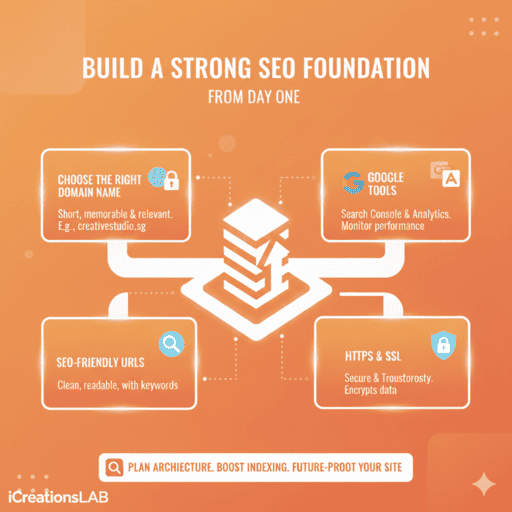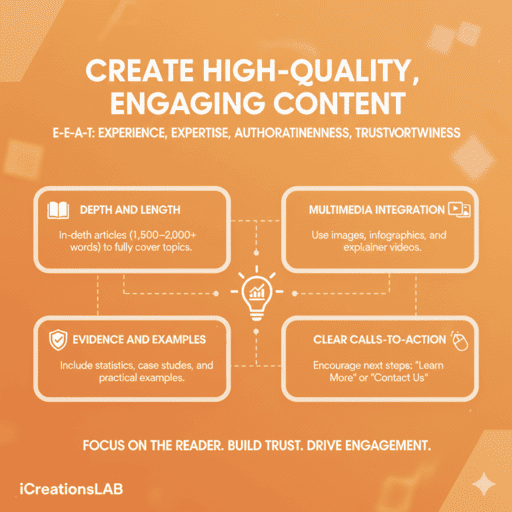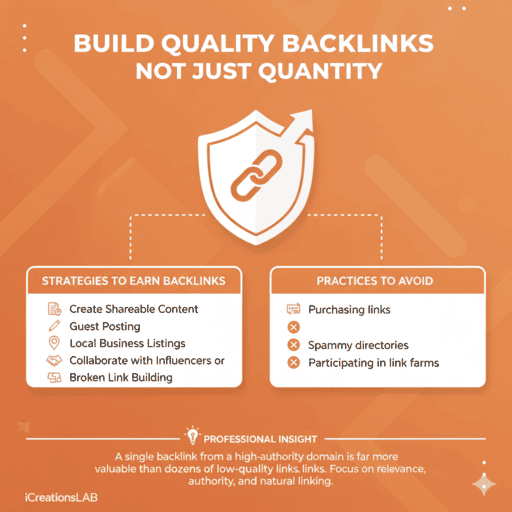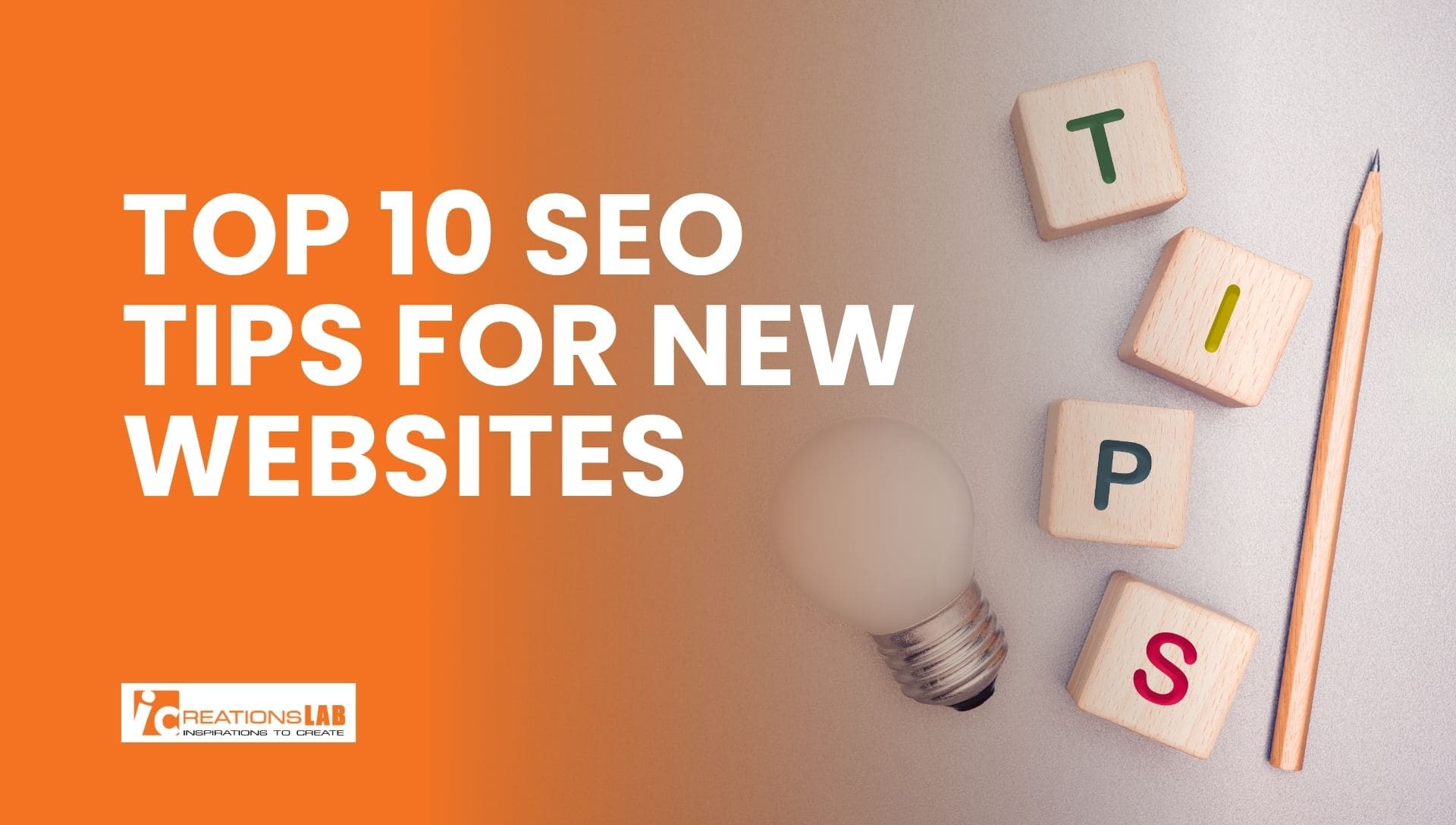Launching a new website is exciting — but without search engine optimization (SEO), it might remain invisible. Every day, millions of new websites go live, but only a few appear on Google’s first page.
This guide reveals the 10 most important SEO tips every new website owner should follow to rank higher, attract quality traffic, and build a sustainable online presence.
1. Build a Strong SEO Foundation from Day One

Many new websites fail to gain visibility because SEO is treated as an afterthought. Effective SEO, however, begins before your first page goes live. Laying a strong foundation ensures that your website is easily crawlable, indexable, and structured for long-term success.
Key Steps to Establish Your SEO Foundation:
- Choose the Right Domain Name:
Select a short, memorable domain that reflects your brand identity. If relevant, incorporate a primary keyword naturally. Avoid complicated strings of characters or numbers. Example: creativestudio.sg instead of creativestudio2025.com. - Set Up Google Search Console and Google Analytics:
These free tools allow you to monitor your website’s performance, track keyword rankings, identify errors, and analyze user behavior from day one. - Create SEO-Friendly URL Structures:
Use clean, readable URLs that include relevant keywords. Example: /web-design-services instead of /page?id=12. Consistent URL patterns make navigation easier for both users and search engines. - Ensure HTTPS & SSL Certification:
Security is a ranking factor and a trust signal for users. An SSL certificate encrypts data, protecting visitors and improving Google trust metrics.
Professional Insight:
Search engines prioritize websites with logical architecture and consistent structure. Planning your site layout and navigation in advance reduces crawl errors, improves indexing, and sets a strong foundation for all future SEO efforts.
See More: Why Website Speed Matters for Google Ranking
2. Conduct Keyword Research the Right Way
Keyword research is the cornerstone of any successful SEO strategy. It identifies what users are searching for and guides content creation so that your website meets actual search demand.
Recommended Tools:
- Google Keyword Planner
- Ahrefs or SEMrush
- Ubersuggest
- Google Trends
Best Practices:
- Focus on Long-Tail Keywords:
Target phrases like “affordable SEO services for small business” rather than short, competitive keywords. Long-tail keywords often have higher conversion rates and lower competition. - Analyze Search Intent:
Determine whether users are looking for information (informational intent), navigating to a specific site (navigational intent), or planning to make a purchase (transactional intent). Align content with intent. - Analyze Competitors:
Use tools like Ahrefs or SEMrush to review competitors’ keywords. Identify gaps where your website can provide unique value.
Professional Insight:
A well-researched keyword list functions as a roadmap for your content strategy. Always create content based on actual user searches, not assumptions about what your audience might want.
3. Optimize On-Page Elements Properly
On-page SEO ensures that each page communicates clearly to search engines what it is about. Optimizing page elements correctly increases visibility, improves rankings, and enhances user experience.
On-Page SEO Checklist:
- Title Tags and H1: Include your primary keyword in the page title, H1 heading, and within the first 100 words of content.
- Meta Descriptions: Write compelling meta descriptions that summarize the page and include a clear call-to-action.
- Headers (H2/H3): Use subheadings to structure content, making it easier to read and crawl.
- Images: Optimize filenames and use descriptive alt text with relevant keywords.
- Internal and External Links: Link to related pages within your site and credible external sources to provide context and authority.
Example:
- Bad: “Our Services”
- Good: “Professional Web Design & SEO Services in Singapore”
Professional Insight:
Each page should focus on one primary keyword and two to three related terms. Avoid keyword stuffing — prioritize readability and user intent over search engine manipulation.
See More: How to Register a Domain Name in Singapore (2025 Guide)
4. Create High-Quality, Engaging Content

Google favors content that educates, solves problems, and keeps users engaged. High-quality content demonstrates Experience, Expertise, Authoritativeness, and Trustworthiness (E-E-A-T), which are essential for rankings.
How to Create SEO-Friendly Content:
- Depth and Length: Create in-depth articles of at least 1,500–2,000 words that fully cover a topic.
- Multimedia Integration: Use images, infographics, and explainer videos to enhance understanding and engagement.
- Evidence and Examples: Include statistics, case studies, and practical examples to build credibility.
- Clear Calls-to-Action: Encourage users to take next steps, such as “Learn More” or “Contact Us.”
Professional Insight:
Long-form content generally performs better in search rankings, but only if it delivers value. Focus on the reader first and SEO second to ensure engagement and trust.
5. Improve Website Speed and Performance
Website performance directly impacts SEO, user experience, and conversion rates. Slow-loading websites reduce dwell time, increase bounce rates, and hurt Google rankings.
Core Web Vitals to Monitor:
- Largest Contentful Paint (LCP): Measures loading performance of the main content.
- Cumulative Layout Shift (CLS): Evaluates visual stability and layout shifts.
- Interaction to Next Paint (INP): Tracks responsiveness to user interactions.
Optimization Checklist:
- Image Optimization: Compress images using tools like TinyPNG or WebP without losing quality.
- Browser Caching and CDN: Implement caching and use a Content Delivery Network like Cloudflare or BunnyCDN to improve load times.
- Minify Code: Reduce unnecessary CSS, JavaScript, and HTML to improve speed.
- Lightweight Themes and Plugins: Remove unused plugins and avoid heavy themes that slow the site.
Professional Insight:
Even a one-second delay can reduce conversions by 7% and page views by 11%. Optimizing speed not only improves search rankings but also enhances overall user satisfaction.
See More: 7 Common Web Page Design Mistakes That Drive Visitors Away
6. Make Your Website Mobile-Friendly
With over 70% of global web traffic coming from mobile devices, ensuring your website performs well on smartphones and tablets is critical. Google uses mobile-first indexing, meaning it evaluates your site’s mobile version as the primary reference for ranking.
Mobile Optimization Best Practices:
- Responsive Design: Ensure that your website layout adjusts fluidly to different screen sizes, from smartphones to large tablets.
- Mobile Usability Testing: Use Google’s Mobile-Friendly Test to identify potential issues such as text size, spacing, or clickable elements.
- Touch-Friendly Elements: Buttons, menus, and interactive elements should be large enough to tap easily, reducing accidental clicks.
- Simplified Navigation: Keep menus concise and structured logically to improve user experience.
- Avoid Intrusive Pop-Ups: Pop-ups that block content can frustrate mobile users and negatively affect rankings.
Professional Insight:
Mobile usability directly affects both user engagement and SEO. A poorly optimized mobile site can lead to high bounce rates, lower session duration, and decreased search visibility. Prioritizing mobile ensures a better experience for the majority of visitors and aligns with Google’s ranking criteria.
7. Strengthen Your Technical SEO
Technical SEO is the foundation that allows search engines to crawl, index, and understand your website effectively. Even the best content cannot rank if the underlying structure of your website is flawed.
Key Technical SEO Tasks:
- XML Sitemap Submission: Create and submit a sitemap to Google Search Console to help search engines discover all important pages.
- Crawl Error Fixes: Identify and correct 404 errors, broken links, and redirect issues to maintain a healthy site structure.
- Structured Data and Schema Markup: Implement schema for reviews, FAQs, products, and articles to enhance search visibility with rich results.
- Canonical Tags: Use canonical tags to prevent duplicate content issues and consolidate ranking signals.
- Robots.txt Optimization: Control which parts of your website should be indexed and which should remain private.
Professional Insight:
Technical SEO acts as the backbone of your website. Issues like slow crawlability, broken links, or duplicate content can undermine even the most well-crafted content and prevent your site from ranking effectively.
See More: 10 Best Website Design & Development Companies 2025
8. Build Quality Backlinks (Not Just Quantity)

Backlinks remain one of the most important ranking factors in Google’s algorithm. High-quality links from authoritative websites act as endorsements, signaling trust and relevance.
Strategies to Earn Backlinks:
- Create Shareable Content: Produce guides, research reports, infographics, or original insights that others naturally want to link to.
- Guest Posting: Contribute valuable content to reputable blogs or industry websites to gain exposure and backlinks.
- Local Business Listings: Submit your website to credible local directories and business listings.
- Collaborate with Influencers or Partners: Partner with industry figures to amplify content and earn mentions.
- Broken Link Building: Find broken links on related sites and offer your content as a replacement.
Practices to Avoid:
- Purchasing links, using spammy directories, or participating in link farms can result in Google penalties.
Professional Insight:
A single backlink from a high-authority domain such as Forbes, HubSpot, or industry-leading publications is far more valuable than dozens of low-quality links. Focus on relevance, authority, and natural linking.
9. Use Analytics and Track Your SEO Progress
SEO requires constant monitoring and optimization. Tracking your performance allows you to understand what strategies are effective and where improvements are needed.
Recommended Analytics Tools:
- Google Search Console: Monitor impressions, clicks, top-performing pages, and keyword positions.
- Google Analytics 4: Analyze user behavior, session duration, bounce rate, and conversion tracking.
- SEO Tools like Ahrefs or SEMrush: Track keyword rankings, backlinks, and competitive analysis.
- User Behavior Tools like Hotjar or Microsoft Clarity: Understand how visitors interact with your pages through heatmaps, session recordings, and scroll depth.
Key Metrics to Monitor:
- Organic traffic growth
- Keyword rankings and visibility
- Click-through rate (CTR) from search results
- Bounce rate and average session duration
- Conversion rate and ROI
Professional Insight:
Data-driven decisions are the key to continuous SEO success. Regular analysis allows you to refine content, improve technical elements, and adjust strategy based on actual user behavior rather than assumptions.
See More: Best Website Builders Compared: Which One Fits Your Business?
10. Build an SEO Strategy for the Long Term
SEO is not a one-time effort; it is a long-term investment. Achieving and maintaining high rankings requires consistency, patience, and adaptation to evolving search engine algorithms.
Long-Term SEO Practices:
- Content Updates: Regularly refresh existing content to keep it relevant and aligned with user intent.
- Algorithm Monitoring: Stay informed about Google updates and adjust strategies to maintain or improve rankings.
- Backlink Growth: Continuously earn high-quality backlinks through content, partnerships, and PR.
- Technical Audits: Conduct comprehensive technical SEO audits at least twice a year to identify and resolve issues.
- Prioritize UX and Content Value: Focus on providing meaningful, fast, and user-friendly experiences.
Professional Insight:
The most successful websites treat SEO as an ongoing business strategy, not a one-time project. Consistent optimization, monitoring, and improvement lead to sustainable growth in visibility and conversions.
Bonus Tip: Integrate SEO with Other Digital Marketing Channels
SEO works best when it complements broader marketing strategies:
- Content Marketing: Blog posts, videos, guides, and whitepapers increase organic reach and engagement.
- Social Media Marketing: Sharing content on social platforms drives traffic and enhances backlink opportunities.
- Email Marketing: Encourages repeat visits and strengthens relationships with users.
- PPC Advertising: Paid campaigns provide short-term traffic while organic SEO efforts mature.
Integrating SEO across all channels amplifies results, improves brand authority, and increases user trust.
See More: Custom UI UX Design Solutions for Businesses in 2025
Conclusion: Start Smart, Grow Strong
The success of your website depends heavily on how effectively you implement SEO strategies from the beginning. Applying these 10 essential SEO tips will help your new website:
- Drive consistent organic traffic
- Improve user experience across devices
- Achieve higher rankings in search results
- Increase conversions and overall ROI
SEO is not just about ranking; it is about creating a website that delivers value, speed, and trust to your visitors. For optimal results, consider partnering with a professional agency that combines technical SEO, content strategy, and web design expertise.
About iCreationsLAB
Established in 2008, iCreationsLAB is a leading web design and SEO company based in Singapore. We specialize in helping businesses transform their websites into high-performing digital assets.
Our Services Include:
- Web Design & Development
- eCommerce Website Solutions
- SEO & Content Marketing
- Web Applications and Custom CMS Development
By combining design, technology, and SEO strategy, iCreationsLAB ensures your website not only looks professional but also ranks effectively and drives measurable business growth.
Visit iCreationsLAB.com to learn how we can help your website reach its full potential.

